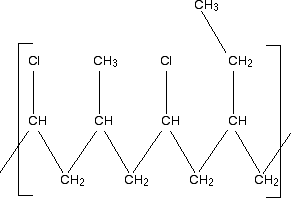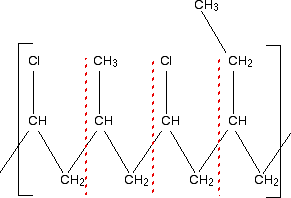|
Chemguide: Support for CIE A level Chemistry Learning outcome 20: Polymerisation 20.1: Addition polymerisation Learning outcomes 20.1.2 and 20.1.3 These statements are all about the relationships between the structures of monomers and the polymers they form. You must expect that the majority of questions relating to these statements will contain examples that you haven't thought about before. Statement 20.1.2 This statement asks you to be able to draw the repeating unit in a polymer from a given monomer. If you have a single monomer This example is not for you to learn. What is important is that you can understand how to come up with the right answer if a similar - but not the same - example is asked. PVA is used widely as a glue. It's name is based on polyvinyl acetate, and the old name for its monomer is vinyl acetate, with the formula CH3COOCH=CH2. So what is the repeating unit in PVA? Because of the carbon-carbon double bond, we are looking at addition polymerisation. The first thing to do is to redraw the formula with the emphasis on the carbon-carbon double bond, like this:
Or, perhaps better, because it shows the structure better:
You would have hints from the way the examiners had drawn the monomer as to which they probably wanted. If in doubt, give as much detail as you can, but don't mess it up by getting any of the detail wrong! Now turn the double bond into a single bond, and draw the bonds showing that the structure continues to the left and right. Then complete it by wrapping the brackets around the repeating unit. Depending on which way you draw the ester group, your final structure would be either
or
You shouldn't find this in any way difficult! If you have more than one monomer The syllabus says ". . . from a given monomer", so you shouldn't really be asked about more than one type of monomer. But don't count on it! You can make a copolymer called EVA, by combining the monomers ethene and vinyl acetate. A copolymer is one made from more than one type of monomer. For exam purposes, you just show the two monomers joining together alternately. (In reality, it isn't as simple as this - you may well just get them joining up randomly. But CIE want the two monomers to be shown in the repeat unit.) So if you combine vinyl acetate and ethene, you would get:
Statement 20.1.3 This is about identifying the monomers which make up a given polymer. In principle, this shouldn't be any more difficult than reversing what you have done above. It is easy if you have a simple polymer like poly(propene) or PVC. But, in fact, it can be quite scary, especially if you are given a really complicated looking structure. Let's make it as difficult as possible! Look at this repeating unit of an entirely imaginary addition polymer:
Notice that there are several different side chains scattered along the main chain. This looks like a fairly complicated example of a copolymer. For an addition polymer, all you need to do is to split it up into two-carbon bits of chain working from the left-hand side.
That gives you the basic monomers. Don't forget to put the double bond back between the two carbon atoms. That means that the monomers of this polymer are:
In an exam, you would obviously just write down the three monomers - not quoting the chloroethene twice. There is nothing difficult about this - just take the polymer to pieces in a systematic way. Important The essential thing when you look at examples like this is not to get panicked by them. But if you take your time, and take the polymer chains to pieces as I have shown you, it really isn't that difficult. Once you have got the basics sorted out, find as many examples as you can from past papers and practise them until they don't bother you any more. You will find that most examples aren't actually as complicated as the one above, but with CIE you must always expect some complication! If you are in the first half of your course, only look at examples from papers 1 and 2. Examples from paper 4 may include another type of polymerisation called condensation polymerisation as well as addition polymerisation. You won't be able to do these at the moment. Good luck!
© Jim Clark 2020 |






